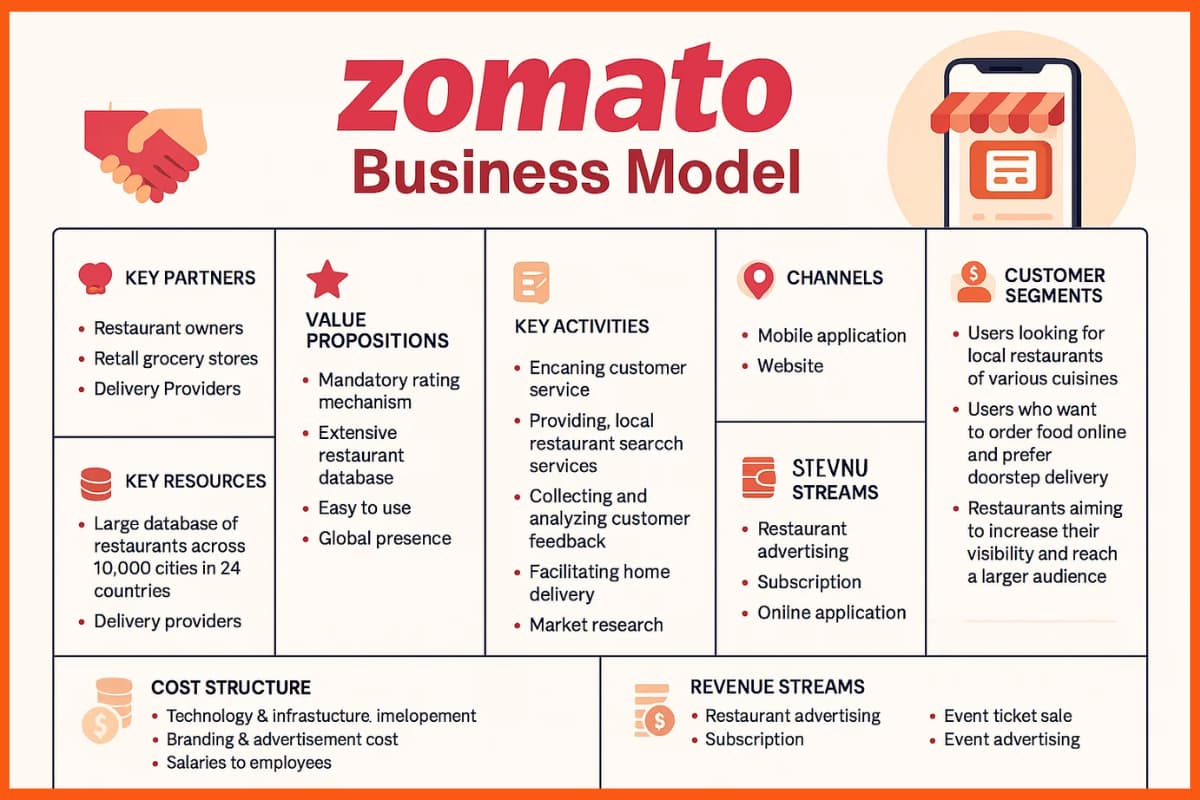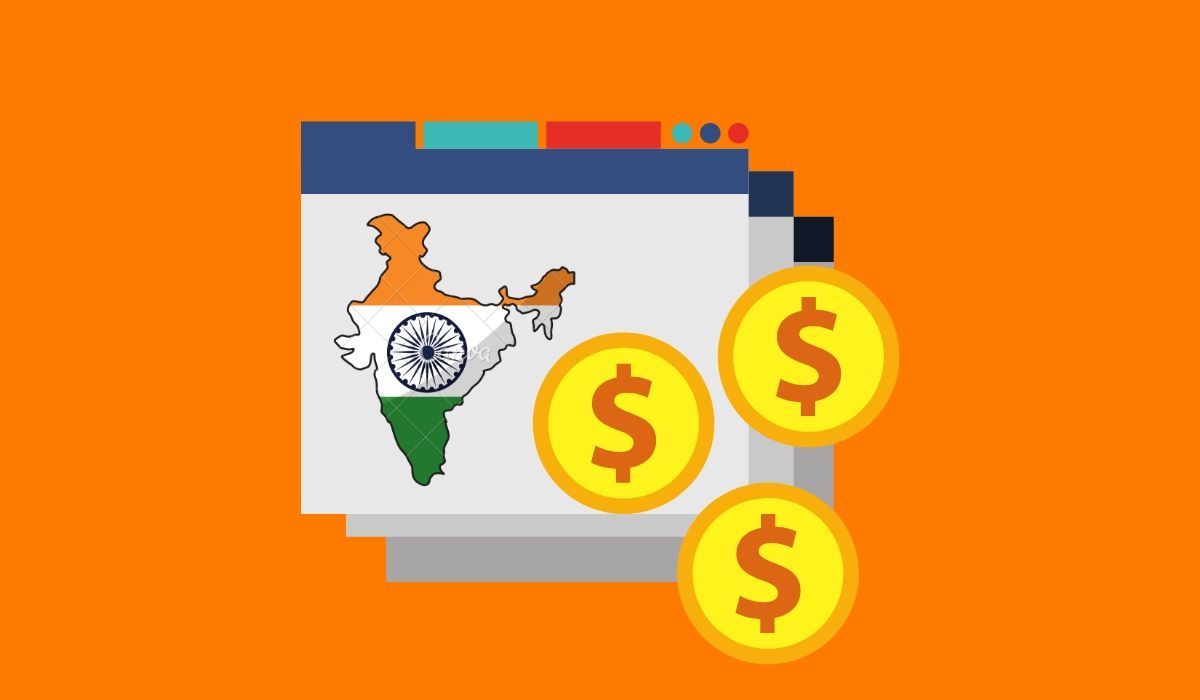Zomato is an Indian restaurant search, discovery, and online food delivery service. The food tech unicorn was founded by Deepinder Goyal and Pankaj Chaddah in 2008. Zomato is well known throughout the country and has also managed to venture into many international markets over the years. It currently operates in 10,000 cities in 24 countries, including the USA, India, Australia, Brazil, New Zealand, Singapore, the United States and in the Middle East Qatar.
Today, Zomato focuses on online food ordering, restaurant reservations, loyalty programs, consultant services, and a lot more. Zomato is also a food search engine that works the same as Google’s search engine but explores a wide range of food and restaurants. The company has grown from a home project to one of the world’s largest food aggregators. Zomato not only connects people to food in every context but also works closely with restaurants to enable a sustainable ecosystem.
With its unique and sustainable business and revenue model, as well as a well-defined organizational structure of Zomato, the company has managed to remain a top player in the market. Zomato has become successful because of factors such as affordability, easy accessibility, and assortment, which have built trust among people from the years of service. Zomato continues to work on finding innovative ways to serve its customers.
Zomato – History

Zomato, which was earlier known as Foodiebay, was established in July 2008 by two IIT graduates, Deepinder Goyal and Pankaj Chaddah. The idea first struck Deepinder when his colleagues consistently had a demand for paper menu leaflets from different restaurants to order food. That is when he thought of converting the restaurants’ paper menus to a digital app, which is far more accessible and easier to use.
In a matter of 9 months, the company grew to become the largest restaurant directory in Delhi and later expanded to other cities due to its success. By 2012, Zomato had started expanding internationally to countries like the UK, South Africa, Qatar, Sri Lanka, South Africa, New Zealand, Brazil, etc. During this course, the company had to change its name since its last four letters of ‘Foodiebay’ coincided with ‘eBay’; the company name was changed to Zomato in 2010 to avoid any legal issues.
In 2015, the company forayed into the food delivery business and went on to launch Gold in India, which was a subscription product under which subscribers would get access to complimentary food and drinks. Zomato also launched Hyperpure, which directly works with Farmers to improve the quality of food produce and supply fresh produce to restaurants. The company now views its business as a combination of three key large pillars: Delivery, Dining Out, and Sustainability.

How Zomato Works: A Simple Guide for Customers & Restaurants

- Search Restaurants: Open the Zomato app or website, enter your location, and explore restaurants by cuisine, name, or deals nearby.
- Check Details: Click on a restaurant to see its menu, prices, photos, reviews, hours, and delivery information, all in one place.
- Place Your Order: Pick your favorite dishes, customize them to your liking, and add them to your cart.
- Make Payment: Pay easily via card, net banking, wallet, or even cash on delivery (if available).
- Track Delivery: Once the order’s confirmed, the restaurant prepares your food, and a Zomato delivery partner brings it right to your door. You can track the delivery in real-time.
- Leave a Review: After your meal, rate the restaurant and share your feedback to help others.
Zomato also helps users discover new places and gives restaurant owners tools to manage their listings, menus, and reviews.
Zomato – Business Model

During the initial phase of the company, Zomato used to scan the menu of the restaurants and keep it on the site, and the menu was received by people. It still follows the same formula but has also added other services to its operation. The business model of Zomato is quite different from that of other food delivery such as Swiggy and Foodpanda. The key partners of Zomato are Uber and London & Partners, which could launch Zomato in the UK within the expected timeline. The business plan of Zomato focuses on expanding its food delivery network, enhancing customer experience, and generating revenue through restaurant partnerships, advertisements, and subscription services.
While the company’s key resource is its large database of restaurants across 10,000 cities in 24 different countries, the business model is based on providing local restaurant search services, collecting data on food menu contacts, and providing relevant information to their customers. The main channels for Zomato are mobile applications and its website. The target audience of the company is the users who try to find local restaurants of various cuisines and restaurants who want their name to reach a large number of people. The Zomato working model is built around connecting customers with restaurants through online food ordering, delivery services, and real-time tracking.
Zomato also caters to customers who prefer home delivery; it helps out database and market research of companies. At the same time, the online service is built with a mandatory rating mechanism. Zomato’s business model has revolutionized the food industry by incorporating various restaurants and making it convenient for people to find restaurants, provide feedback, and food business industries by incorporating various listings and availability according to their choice of cuisine.
Zomato – Expansion & Impact
- Zomato employs over 5,000 individuals, spanning diverse roles and compensation levels.
- The monthly user base is 80 million users.
- Zomato continually expands its platform, adding a new restaurant every 30 seconds.
- Presence established in 24 countries.
- Available in multiple languages, including Turkish, Portuguese, Indonesian, English, Hindi, and some regional Indian languages.
Zomato – Revenue Model | How Zomato Earns Money

Zomato Yearly Financials
| Particulars | FY24 | FY23 |
|---|---|---|
| Total Revenue | 12,961 crore | 7,760.9 Cr |
| Revenue from operations | INR 12,114 crore | INR 7,079.4 crore |
| Other income | INR 847 crore | INR 681.5 crore |
| Profit/(Loss) before tax | INR 291 crore | (INR 1,014.6 crore) |
| Tax expense | (INR 60 crore) | (INR 43.6 crore) |
| Current tax | INR 1 crore | INR 0.4 crore |
| Deferred tax | (INR 61 crore) | (INR 44 crore) |
| Profit/(Loss) for the year | Profit of INR 351 crore | Loss of INR 917 crore |
Zomato, in itself, does not offer the products to customers, but the revenue model of Zomato is massive. Zomato is not just a food business; it is also in the advertising business. Zomato turnover has seen significant growth over the years, reflecting the company’s expanding presence in the online food delivery market. Zomato’s business has two parts: one is the delivery business, and two is the advertising business. Today, Zomato has multiple revenue streams besides online ordering, which most consumers would be familiar with. Zomato’s profit for the year 2024 was INR 351 crore.
Zomato Expense Breakdown
| Zomato Expense Breakdown | FY24 | FY23 |
|---|---|---|
| Total Expenses | INR 12,670 crore | INR 8,775.3 crore |
| Purchase of stock-in-trade | INR 2,887 crore | INR 1,438.2 crore |
| Changes in inventories | (INR 5 crore) | (INR 43 crore) |
| Employee benefit expense | INR 1,659 crore | INR 1,465 crore |
| Finance costs | INR 72 crore | INR 48.7 crore |
| Amortization & Depreciation | INR 526 crore | INR 436.9 crore |
| Other expenses | INR 7,531 crore | INR 5,429.5 crore |
Zomato saw growth in FY24, with its operating revenue increasing by 70.8%, reaching INR 12,114 crore compared to INR 7,079.4 crore in FY23. The company also turned profitable, posting a profit of INR 351 crore in FY24, compared to a loss of INR 917 crore in FY23. However, total expenses increased by 44.4% to INR 12,670 crore in FY24, up from INR 8,775.3 crore in FY23.
Restaurant Listings and Advertising
Zomato first started as a restaurant search and rating service. This brought in the advertising revenues from restaurants who joined the platform. They further extended this feature to food delivery and restaurant reservations; for this, Zomato charges commissions from restaurants that want to be placed on the feed. Advertising is Zomato’s major source of revenue. The restaurants can promote their banner on the site in order to get better visibility and appeal to a large section of the audience via Zomato.
Food Delivery

Through the food delivery business, Zomato charges a commission to the restaurants based on orders. The company earns through restaurants that pay a commission for each delivery, which is then split among the delivery partners and the company. Zomato imposes a commission ranging from 20% to 25% on each order made at a specific restaurant, with potential variations in commission rates from 5% to 7% in certain regions. However, online food delivery only contributes a low percentage of income compared to other revenue streams because of the huge competition and the need to provide deep discounts.
Subscription Programs
The next major source of revenue for Zomato is a subscription fee. Restaurants pay a certain fee monthly; in return, Zomato offers them the analytical tools. Zomato has a huge number of databases that know what a customer wants to eat, where he/she wants to eat, and what the consumers are searching for, and it is given to restaurants, which helps them know about all this information through the cookies. It has a tool called Zomato Order which is given to restaurants, which tells them about consumers’ interests. The restaurants then use this tool to flash their discount offers on food.
Live Events

Zomato has forayed into the events space by partnering with restaurants and creating limited events. By which they made a sale through the price of the tickets. Zomato recently introduced Zomaland and entered the live event market in 2019. Zomato charges users an entry fee to attend Zomaland, where, besides food, they can witness live musical performances and other acts. Zomato also organized an entertainment carnival in 2018 in Delhi, Pune and Bengaluru, where more than 100 thousand people showed up.
White Label Access
The next source of revenue is app development. Zomato launched a service called Zomato Whitelabel, under which they give offers to restaurants to develop customized food delivery apps. It also works with cloud kitchens and restaurants for consultancy services. Zomato works with selected restaurant operators to help in identifying locations for expansions at a minimal fixed cost but with increased options for the user. It provides the requisite licenses and operational enablement for such restaurant partners.

Data Insights
Zomato studies how people use its app and how restaurants perform. It shares this information with restaurants and others in the food business. This helps restaurants improve their menu, prices, and promotions. Zomato also uses the data to make its app better. It earns money by charging a fee for sharing this data.
Zomato Kitchens
Zomato also provides kitchen infrastructure services to select restaurant operators; it works with entrepreneurs to set up and operate Zomato kitchens under various other labels. This helps entrepreneurs fund restaurants in the right location with an investment of INR 35 lakhs. It also claims to offer returns in the range of INR 2 lakh to INR 4 lakh per month to investors and has so far completed more than 180 affiliated kitchens.
Zomato Gold

Zomato Gold is a premium subscription service offered by Zomato, providing members with exclusive dining benefits. Subscribers enjoy complimentary dishes or drinks at partner restaurants, making dining out a more rewarding experience. The service aims to enhance the dining lifestyle by offering special privileges and discounts at a wide range of top-rated eateries. Zomato Gold caters to food enthusiasts seeking unique culinary experiences while enjoying cost-effective perks. It has become a popular choice for those who appreciate both quality dining and savings.

Zomato – Value Proposition

Zomato Revenue Breakdown
| Zomato Revenue Streams | FY22 | FY23 |
|---|---|---|
| Food Order & Delivery | INR 3414 crore | INR 4533 crore |
| HyperPure Supplies B2B | INR 537 crore | INR 1506 crore |
| Others | INR 241 crore | INR 234 crore |
| Blinkit | – | INR 806 crore |
The total revenue generated by Zomato in FY 22 was INR 4192 crore whereas its turnover in FY 2023 was INR 7079 crore.
The business model of Zomato offers a variety of value to its customers, while Zomato’s revenue model focus has been on creating something new and extra that the customers cannot get anywhere else. Zomato is a one-stop shop for dinners and offers a way for restaurants to differentiate themselves. Restaurants have an option to create differentiation by keeping the listing updated, responding to criticism positively, and also by being accountable for their action.

Conclusion
Zomato’s business plan believes in creating value for its customers to sustain its business operations. The company endeavors to bridge the gap between customers and restaurants by providing efficient technology applications, which, as outlined in the business plan, has played a crucial role in reducing delivery times and enhancing overall service quality. Zomato business plan focuses on food delivery, restaurant listings, and data insights to create a profitable and scalable model in the food tech industry.
FAQs
What is Zomato?
Zomato is an online platform that offers food delivery and helps users discover restaurants with various dining options available.
What is Zomato Business Model?
Business model of Zomato is a commission-based model, charging restaurants a percentage fee for orders through its platform. Revenue is generated via subscription services, including Zomato Gold, which grants exclusive dining benefits.
How Zomato works?
Zomato connects users with restaurants by allowing them to browse menus, read reviews, and order food for delivery or pickup. It also offers table reservations and subscription services like Zomato Pro for discounts. Restaurants can list their services and manage orders through the platform.
What is the revenue of Zomato?
Zomato’s revenue is ₹12,961 crore (2024).
How to contact Zomato for business?
You can contact Zomato through email to start a business with them.
What is Zomato for business apps?
The Zomato for Business app is for business owners. It is an interface with powerful features to get the most out of your Zomato listing.
Zomato operates in how many countries?
Zomato operates in 10,000 cities in 24 countries, including the USA, India, Australia, Brazil, New Zealand, Singapore, the United States, and in the Middle East Qatar.
What is Zomato revenue model?
Zomato’s revenue model is based on several key sources. It earns a commission from restaurants for each food delivery order placed through its platform. Additionally, Zomato generates income from advertising by allowing restaurants to pay for premium listings and visibility. The subscription service Zomato Pro brings in revenue from users who access discounts and exclusive deals. Zomato also makes money through Hyperpure, which supplies quality ingredients to restaurants. These revenue streams help Zomato sustain and grow its business.
What are Zomato products and services?
Products and services offered by zomato include food delivery, restaurant discovery, and table reservations. It allows users to explore local dining options, read reviews, and place orders online. Zomato Pro offers members discounts at partner restaurants, while Hyperpure supplies fresh ingredients to restaurants. These services help Zomato connect customers with restaurants and enhance the dining experience.














































